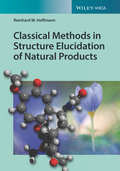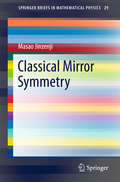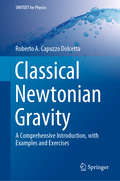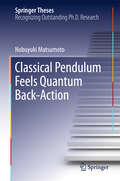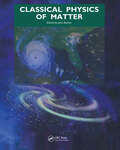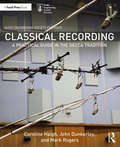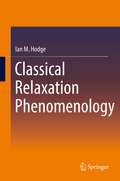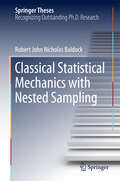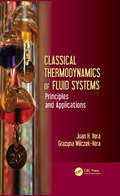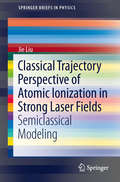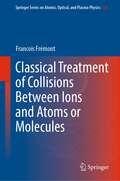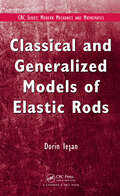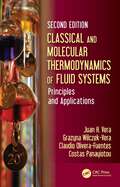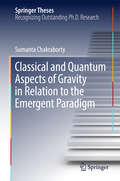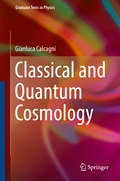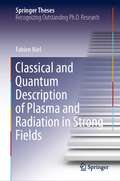- Table View
- List View
Classical Methods in Structure Elucidation of Natural Products
by Reinhard W. HoffmannOrganic chemistry as we know it today originated from a preoccupation with substances isolated from nature. In the period from 1860 to 1960, the main task was to elucidate their molecular structure by way of degradation and synthesis. In light of the limited experimental methods available and the lack of established reference compounds, this represented an unparalleled intellectual challenge. This book makes use of twenty-five representative examples to retrace the great accomplishments made by the generation of chemists during this era. At the same time, it questions the reliability of the experimental results when judged by today's criteria, particularly since the structures for numerous natural products are stated as established facts in standard text books. With each chapter devoted to one organic compound, the author combines results from historic experiments to trace a line of evidence that may follow the path put forward by the original contributors. However, in some cases the experimental facts have been combined to form another, hopefully shorter, line of evidence. As a result, readers are able to determine for themselves the 'facts behind the established structure assignments' of a number of important natural products.
Classical Mirror Symmetry (SpringerBriefs In Mathematical Physics #29)
by Masao JinzenjiThis book furnishes a brief introduction to classical mirror symmetry, a term that denotes the process of computing Gromov–Witten invariants of a Calabi–Yau threefold by using the Picard–Fuchs differential equation of period integrals of its mirror Calabi–Yau threefold. The book concentrates on the best-known example, the quintic hypersurface in 4-dimensional projective space, and its mirror manifold.First, there is a brief review of the process of discovery of mirror symmetry and the striking result proposed in the celebrated paper by Candelas and his collaborators. Next, some elementary results of complex manifolds and Chern classes needed for study of mirror symmetry are explained. Then the topological sigma models, the A-model and the B-model, are introduced. The classical mirror symmetry hypothesis is explained as the equivalence between the correlation function of the A-model of a quintic hyper-surface and that of the B-model of its mirror manifold.On the B-model side, the process of construction of a pair of mirror Calabi–Yau threefold using toric geometry is briefly explained. Also given are detailed explanations of the derivation of the Picard–Fuchs differential equation of the period integrals and on the process of deriving the instanton expansion of the A-model Yukawa coupling based on the mirror symmetry hypothesis.On the A-model side, the moduli space of degree d quasimaps from CP^1 with two marked points to CP^4 is introduced, with reconstruction of the period integrals used in the B-model side as generating functions of the intersection numbers of the moduli space. Lastly, a mathematical justification for the process of the B-model computation from the point of view of the geometry of the moduli space of quasimaps is given.The style of description is between that of mathematics and physics, with the assumption that readers have standard graduate student backgrounds in both disciplines.
Classical Mythology of the Constellations: Timeless Tales of the Starry Night Sky
by Annette GieseckeA retelling of the classic myths and timeless tales by bestselling author Annette Giesecke that underlie the 88 named constellations in the night sky--from Andromeda to Orion to Ursa Major.Classical Mythology of the Constellations is a stargazer's guide to the wondrous stories of the gods, heroes, and monsters that populate the night sky. As long as humans have lived on Earth, they have gazed up at the starry sky with fascination and longing. For the ancient Greeks and Romans, the Sun, Moon, and Earth were gods. The stars beyond our Solar System, however, represented heroes, animals, and monsters that the gods placed in the sky after their death. These include the great hunter Orion and the scorpion who killed him with its sting, the beautiful maiden Callisto who was turned into a bear (Ursa Major) by the goddess Hera, Perseus, the slayer of Medusa, and many more. In this beautifully designed work, stunningly illustrated by Jim Tierney, Giesecke tells the origin stories of the 48 constellations, first catalogued by the astronomer Ptolemy in the second century CE. A final section covers the names, locations, and brief descriptions of the remaining 40 constellations catalogued by astronomers in the sixteenth, seventeenth, and eighteenth centuries, which are not named for Classical figures. Organized by hemisphere and celestial quadrant, the book also includes two illustrated star maps to help guide the reader to the location of each constellation, as well as 48 color plates throughout.
Classical Newtonian Gravity: A Comprehensive Introduction, with Examples and Exercises (UNITEXT for Physics)
by Roberto A. Capuzzo DolcettaThis textbook offers a readily comprehensible introduction to classical Newtonian gravitation, which is fundamental for an understanding of classical mechanics and is particularly relevant to Astrophysics. The opening chapter recalls essential elements of vectorial calculus, especially to provide the formalism used in subsequent chapters. In chapter two Classical Newtonian gravity theory for one point mass and for a generic number N of point masses is then presented and discussed. The theory for point masses is naturally extended to the continuous case. The third chapter addresses the paradigmatic case of spherical symmetry in the mass density distribution (central force), with introduction of the useful tool of qualitative treatment of motion. Subsequent chapters discuss the general case of non-symmetric mass density distribution and develop classical potential theory, with elements of harmonic theory, which is essential to understand the potential development in series of the gravitational potential, the subject of the fourth chapter. Finally, in the last chapter the specific case of motion of a satellite around the earth is considered. Examples and exercises are presented throughout the book to clarify aspects of the theory. The book is aimed at those who wish to progress further beyond an initial bachelor degree, onward to a master degree, and a PhD. It is also a valuable resource for postgraduates and active researchers in the field.
Classical Optics and its Applications
by Masud MansuripurCovering a broad range of fundamental topics in classical optics and electro-magnetism, this book is ideal for graduate-level courses in optics, providing supplementary reading materials for teachers and students alike. Industrial scientists and engineers developing modern optical systems will also find it an invaluable resource. Now in color, this second edition contains 13 new chapters, covering optical pulse compression, the Hanbury Brown-Twiss experiment, the Sagnac effect, Doppler shift and stellar aberration, and optics of semiconductor diode lasers. The first half of the book deals primarily with the basic concepts of optics, while the second half describes how these concepts can be used in a variety of technological applications. Each chapter is concerned with a single topic, developing an understanding through the use of diagrams, examples, numerical simulations, and logical arguments. The mathematical content is kept to a minimum to provide the reader with insightful discussions of optical phenomena.
Classical Pendulum Feels Quantum Back-Action (Springer Theses)
by Nobuyuki MatsumotoIn this thesis, ultimate sensitive measurement forweak force imposed on a suspended mirror is performed with the help of a laserand an optical cavity for the development of gravitational-wave detectors. According to the Heisenberg uncertainty principle, such measurements aresubject to a fundamental noise called quantum noise, which arises from thequantum nature of a probe (light) and a measured object (mirror). One of thesources of quantum noise is the quantum back-action, which arises from thevacuum fluctuation of the light. It sways the mirror via the momentumtransferred to the mirror upon its reflection for the measurement. The authordiscusses a fundamental trade-off between sensitivity and stability in themacroscopic system, and suggests using a triangular cavity that can avoid thistrade-off. The development of an optical triangular cavity is described and itscharacterization of the optomechanical effect in the triangular cavity isdemonstrated. As a result, for the first time in the world the quantum back-actionimposed on the 5-mg suspended mirror is significantly evaluated. This workcontributes to overcoming the standard quantum limit in the future.
Classical Physics of Matter (Malvern Physics Series)
by J BoltonClassical Physics of Matter explores the properties of matter that can be explained more or less directly in terms of classical physics. Among the topics discussed are the principles of flight and the operation of engines and refrigerators. The discussion introduces ideas such as temperature, heat, and entropy that will take you beyond Newtonian me
Classical Probability in the Enlightenment
by Lorraine DastonWhat did it mean to be reasonable in the Age of Reason? Classical probabilists from Jakob Bernouli through Pierre Simon Laplace intended their theory as an answer to this question--as "nothing more at bottom than good sense reduced to a calculus," in Laplace's words. In terms that can be easily grasped by nonmathematicians, Lorraine Daston demonstrates how this view profoundly shaped the internal development of probability theory and defined its applications.
Classical Probability in the Enlightenment, New Edition
by Lorraine DastonAn award-winning history of the Enlightenment quest to devise a mathematical model of rationalityWhat did it mean to be reasonable in the Age of Reason? Enlightenment mathematicians such as Blaise Pascal, Jakob Bernoulli, and Pierre Simon Laplace sought to answer this question, laboring over a theory of rational decision, action, and belief under conditions of uncertainty. Lorraine Daston brings to life their debates and philosophical arguments, charting the development and application of probability theory by some of the greatest thinkers of the age. Now with an incisive new preface, Classical Probability in the Enlightenment traces the emergence of new kind of mathematics designed to turn good sense into a reasonable calculus.
Classical Recording: A Practical Guide in the Decca Tradition (Audio Engineering Society Presents)
by Mark Rogers Caroline Haigh John DunkerleyClassical Recording: A Practical Guide in the Decca Tradition is the authoritative guide to all aspects of recording acoustic classical music. Offering detailed descriptions, diagrams, and photographs of fundamental recording techniques such as the Decca tree, this book offers a comprehensive overview of the essential skills involved in successfully producing a classical recording. Written by engineers with years of experience working for Decca and Abbey Road Studios and as freelancers, Classical Recording equips the student, the interested amateur, and the practising professional with the required knowledge and confidence to tackle everything from solo piano to opera.
Classical Relaxation Phenomenology
by Ian M. HodgeThis book serves as a self-contained reference source for engineers, materials scientists, and physicists with an interest in relaxation phenomena. It is made accessible to students and those new to the field by the inclusion of both elementary and advanced math techniques, as well as chapter opening summaries that cover relevant background information and enhance the book's pedagogical value. These summaries cover a wide gamut from elementary to advanced topics.The book is divided into three parts. The opening part, on mathematics, presents the core techniques and approaches. Parts II and III then apply the mathematics to electrical relaxation and structural relaxation, respectively. Part II discusses relaxation of polarization at both constant electric field (dielectric relaxation) and constant displacement (conductivity relaxation), topics that are not often discussed together. Part III primarily discusses enthalpy relaxation of amorphous materials within and below the glass transition temperature range. It takes a practical approach inspired by applied mathematics in which detailed rigorous proofs are eschewed in favor of describing practical tools that are useful to scientists and engineers. Derivations are however given when these provide physical insight and/or connections to other material.A self-contained reference on relaxation phenomenaDetails both the mathematical basis and applicationsFor engineers, materials scientists, and physicists
Classical Solutions in Quantum Field Theory
by Erick J. WeinbergClassical solutions play an important role in quantum field theory, high energy physics and cosmology. Real-time soliton solutions give rise to particles, such as magnetic monopoles, and extended structures, such as domain walls and cosmic strings, that have implications for early universe cosmology. Imaginary-time Euclidean instantons are responsible for important nonperturbative effects, while Euclidean bounce solutions govern transitions between metastable states. Written for advanced graduate students and researchers in elementary particle physics, cosmology and related fields, this book brings the reader up to the level of current research in the field. The first half of the book discusses the most important classes of solitons: kinks, vortices and magnetic monopoles. The cosmological and observational constraints on these are covered, as are more formal aspects, including BPS solitons and their connection with supersymmetry. The second half is devoted to Euclidean solutions, with particular emphasis on Yang-Mills instantons and on bounce solutions.
Classical Statistical Mechanics with Nested Sampling (Springer Theses)
by Robert John Nicholas BaldockThis thesis develops a nested sampling algorithm into a black box tool for directly calculating the partition function, and thus the complete phase diagram of a material, from the interatomic potential energy function. It represents a significant step forward in our ability to accurately describe the finite temperature properties of materials. In principle, the macroscopic phases of matter are related to the microscopic interactions of atoms by statistical mechanics and the partition function. In practice, direct calculation of the partition function has proved infeasible for realistic models of atomic interactions, even with modern atomistic simulation methods. The thesis also shows how the output of nested sampling calculations can be processed to calculate the complete PVT (pressure-volume-temperature) equation of state for a material, and applies the nested sampling algorithm to calculate the pressure-temperature phase diagrams of aluminium and a model binary alloy.
Classical Systems in Quantum Mechanics
by Pavel BónaThis book investigates two possibilities for describing classical-mechanical physical systems along with their Hamiltonian dynamics in the framework of quantum mechanics.The first possibility consists in exploiting the geometrical properties of the set of quantum pure states of "microsystems" and of the Lie groups characterizing the specific classical system. The second approach is to consider quantal systems of a large number of interacting subsystems – i.e. macrosystems, so as to study the quantum mechanics of an infinite number of degrees of freedom and to look for the behaviour of their collective variables. The final chapter contains some solvable models of “quantum measurement" describing dynamical transitions from "microsystems" to "macrosystems".
Classical Theory of Electricity and Magnetism: A Course of Lectures (Texts and Readings in Physical Sciences #21)
by Amal Kumar RaychaudhuriThis book examines the topics of magnetohydrodynamics and plasma oscillations, in addition to the standard topics discussed to cover courses in electromagnestism, electrodynamics, and fundamentals of physics, to name a few. This textbook on electricity and magnetism is primarily targeted at graduate students of physics. The undergraduate students of physics also find the treatment of the subject useful. The treatment of the special theory of relativity clearly emphasises the Lorentz covariance of Maxwell's equations. The rather abstruse topic of radiation reaction is covered at an elementary level, and the Wheeler–Feynman absorber theory has been dwelt upon briefly in the book.
Classical Thermodynamics of Fluid Systems: Principles and Applications
by Juan H. Vera Grazyna Wilczek-VeraThis text explores the connections between different thermodynamic subjects related to fluid systems. Emphasis is placed on the clarification of concepts by returning to the conceptual foundation of thermodynamics and special effort is directed to the use of a simple nomenclature and algebra. The book presents the structural elements of classical thermodynamics of fluid systems, covers the treatment of mixtures, and shows via examples and references both the usefulness and the limitations of classical thermodynamics for the treatment of practical problems related to fluid systems. It also includes diverse selected topics of interest to researchers and advanced students and four practical appendices, including an introduction to material balances and step-by-step procedures for using the Virial EOS and the PRSV EOS for fugacities and the ASOG-KT group method for activity coefficients. The Olivera-Fuentes table of PRSV parameters for more than 800 chemical compounds and the Gmehling-Tochigi tables of ASOG interaction parameters for 43 groups are included.
Classical Trajectory Perspective of Atomic Ionization in Strong Laser Fields: Semiclassical Modeling (SpringerBriefs in Physics)
by Jie LiuThe ionization of atoms and molecules in strong laser fields is an active field in modern physics and has versatile applications in such as attosecond physics, X-ray generation, inertial confined fusion (ICF), medical science and so on. Classical Trajectory Perspective of Atomic Ionization in Strong Laser Fields covers the basic concepts in this field and discusses many interesting topics using the semiclassical model of classical trajectory ensemble simulation, which is one of the most successful ionization models and has the advantages of a clear picture, feasible computing and accounting for many exquisite experiments quantitatively. The book also presents many applications of the model in such topics as the single ionization, double ionization, neutral atom acceleration and other timely issues in strong field physics, and delivers useful messages to readers with presenting the classical trajectory perspective on the strong field atomic ionization. The book is intended for graduate students and researchers in the field of laser physics, atom molecule physics and theoretical physics. Dr. Jie Liu is a professor of Institute of Applied Physics and Computational Mathematics, China and Peking University.
Classical Treatment of Collisions Between Ions and Atoms or Molecules (Springer Series on Atomic, Optical, and Plasma Physics #118)
by Francois FrémontSince the beginning of the twentieth century, many experimental and theoretical works have been devoted to collisions between highly charged ions and atomic and molecular targets. It was realized that quantum mechanics is the only way, a priori, to describe such atomic phenomena. However, since quantum mechanics is very difficult to apply for collision systems with more than two particles, classical methods were very soon introduced and applied to simple collision systems and, subsequently, to more complicated systems. The results obtained by such classical methods were found to be surprisingly good, and classical mechanics is now well established, despite its approximations, as a replacement for or competition with quantum mechanics in many cases.In this book, the author will focus on the development of classical methods for describing collisional and post-collisional processes. The results will be compared with those found using quantum mechanical models, in order to demonstrate the ability of the classical approach to obtain many features and details of collision systems.
Classical and Generalized Models of Elastic Rods (Modern Mechanics and Mathematics)
by D. IesanReflecting new developments in the study of Saint-Venant's problem, Classical and Generalized Models of Elastic Rods focuses on the deformation of elastic cylinders for three models of continuum: classical elastic continuum, Cosserat elastic body, and porous elastic material. The author presents a method to construct Saint-Venant's solutions, minim
Classical and Molecular Thermodynamics of Fluid Systems: Principles and Applications
by Juan H. Vera Grazyna Wilczek-Vera Claudio Olivera-Fuentes Costas PanayiotouThis text explores the connections between different thermodynamic subjects related to fluid systems. In an innovative way, it covers the subject from first principles to the state of the art in fundamental and applied topics. Using simple nomenclature and algebra, it clarifies concepts by returning to the conceptual foundation of thermodynamics. The structural elements of classical and molecular thermodynamics of fluid systems presented cover, via examples and references, both the usefulness and the limitations of thermodynamics for the treatment of practical problems. This new edition explores recent advances in statistical associated fluid theories and contains creative end‑of‑chapter problems connecting the theory with real‑life situations. It includes new chapters on thermodynamics of polymer solutions and molecular thermodynamics and also presents advances in the study of the activity of individual ions. Provides a concise structure of concepts, using simple nomenclature and algebra Clarifies problems usually overlooked by standard texts Features end‑of‑chapter problems to enhance the reader’s understanding of the concepts Includes diverse topics of interest to researchers and advanced students, including elements of statistical thermodynamics, models of solutions, statistical associated fluid theory and the activity of individual ions Offers four appendices giving step‑by‑step procedures and parameters for direct use of the PRSV equation of state and the ASOG‑KT group method for fugacity and activity coefficient calculations Features a complete set of solutions to problems throughout the book, available for download on the book’s webpage under "Support Material" This textbook is written for advanced undergraduate and graduate students studying chemical engineering and chemistry as well as for practicing engineers and researchers.
Classical and Quantum Aspects of Gravity in Relation to the Emergent Paradigm (Springer Theses)
by Sumanta ChakrabortyThis thesis explores the connection between gravity and thermodynamics and provides a unification scheme that opens up new directions of exploration. Further elaborating on the Hawking effect and the possibility of singularity avoidance, the author not only discusses the information loss paradox at a broader level but also provides a possible solution to it. As the final frontier, it describes some novel effects arising from the microscopic structure of spacetime. Taken as a whole, the thesis addresses three major research areas in gravitational physics: it starts with classical gravity, proceeds to the black hole information loss paradox, and closes with Planck scale physics. The thesis is written in a lucid and pedagogical style, with an introduction accessible to researchers from other branches of physics and a discussion presenting open questions and future directions, which will benefit and hopefully inspire next-generation researchers.
Classical and Quantum Cosmology (Graduate Texts in Physics)
by Gianluca CalcagniThis comprehensive textbook is devoted to classical and quantum cosmology, with particular emphasis on modern approaches to quantum gravity and string theory and on their observational imprint. It covers major challenges in theoretical physics such as the big bang and the cosmological constant problem. An extensive review of standard cosmology, the cosmic microwave background, inflation and dark energy sets the scene for the phenomenological application of all the main quantum-gravity and string-theory models of cosmology. Born of the author's teaching experience and commitment to bridging the gap between cosmologists and theoreticians working beyond the established laws of particle physics and general relativity, this is a unique text where quantum-gravity approaches and string theory are treated on an equal footing. As well as introducing cosmology to undergraduate and graduate students with its pedagogical presentation and the help of 45 solved exercises, this book, which includes an ambitious bibliography of about 3500 items, will serve as a valuable reference for lecturers and researchers.
Classical and Quantum Description of Plasma and Radiation in Strong Fields (Springer Theses)
by Fabien NielThis thesis presents several important aspects of the plasma dynamics in extremely high intensity electromagnetic fields when quantum electrodynamics effects have to be taken into account. This work is of utmost importance for the forthcoming generation of multipetawatt laser facilities where this physics will be tested. The first part consists of an introduction that extends from classical and quantum electrodynamics in strong fields to the kinetic description of plasmas in the interaction with such fields. This can be considered as an advanced tutorial which would be extremely useful to researchers and students new to the field. The second part describes original contributions on the analysis of the signatures of classical and quantum radiation reaction on the distribution function of the charged particles and of the photon spectrum, and leads to significant advances on this topic. These results are then extended to the analysis of the so-called QED cascades which are of central importance for a better understanding of some astrophysical phenomena and basic physics problems. Finally, the book discusses future directions for the high intensity laser–plasma interaction community. The results presented in this thesis are expected to become more and more relevant as the new multipetawatt facilities become operative.
Classical and Quantum Dynamics: From Classical Paths to Path Integrals (Graduate Texts In Physics Ser.)
by Martin Reuter Walter DittrichGraduate students seeking to become familiar with advanced computational strategies in classical and quantum dynamics will find in this book both the fundamentals of a standard course and a detailed treatment of the time-dependent oscillator, Chern-Simons mechanics, the Maslov anomaly and the Berry phase, to name just a few topics. Well-chosen and detailed examples illustrate perturbation theory, canonical transformations and the action principle, and demonstrate the usage of path integrals. The sixth edition has been enlarged to include the Heisenberg-Euler Lagrangian, Schwinger’s source theory treatment of the low-energy π-ρ-N physics and general relativity, where Riemann’s (Einstein’s) ideas on space and time and their philosophical implications are discussed.
Classical and Quantum Dynamics: From Classical Paths to Path Integrals (Graduate Texts in Physics)
by Martin Reuter Walter DittrichGraduate students who want to become familiar with advanced computational strategies in classical and quantum dynamics will find here both the fundamentals of a standard course and a detailed treatment of the time-dependent oscillator, Chern-Simons mechanics, the Maslov anomaly and the Berry phase, to name a few. Well-chosen and detailed examples illustrate the perturbation theory, canonical transformations, the action principle and demonstrate the usage of path integrals. This new edition has been revised and enlarged with chapters on quantum electrodynamics, high energy physics, Green's functions and strong interaction. "This book is a brilliant exposition of dynamical systems covering the essential aspects and written in an elegant manner. The book is written in modern language of mathematics and will ideally cater to the requirements of graduate and first year Ph. D. students. . . a wonderful introduction to any student who wants to do research in any branch of theoretical Physics. " (Indian Journal of Physics)
